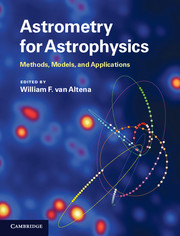Book contents
- Frontmatter
- Contents
- List of contributors
- List of acronyms
- Preface
- Part I Astrometry in the twenty-first century
- Part II Foundations of astrometry and celestial mechanics
- Part III Observing through the atmosphere
- 9 The Earth's atmosphere: refraction, turbulence, delays, and limitations to astrometric precision
- 10 Astrometry with ground-based diffraction-limited imaging
- 11 Optical interferometry
- 12 Radio astrometry
- Part IV From detected photons to the celestial sphere
- Part V Applications of astrometry to topics in astrophysics
- Index
- References
11 - Optical interferometry
from Part III - Observing through the atmosphere
Published online by Cambridge University Press: 05 December 2012
- Frontmatter
- Contents
- List of contributors
- List of acronyms
- Preface
- Part I Astrometry in the twenty-first century
- Part II Foundations of astrometry and celestial mechanics
- Part III Observing through the atmosphere
- 9 The Earth's atmosphere: refraction, turbulence, delays, and limitations to astrometric precision
- 10 Astrometry with ground-based diffraction-limited imaging
- 11 Optical interferometry
- 12 Radio astrometry
- Part IV From detected photons to the celestial sphere
- Part V Applications of astrometry to topics in astrophysics
- Index
- References
Summary
Introduction
Less than 300 years after Galilei's first telescope observations of celestial objects, Fizeau (1868) suggested a way to improve the measurement of stellar diameters by masking the telescope aperture with two small sub-apertures. Light passing through these sub-apertures would then interfere in the telescope focal plane. The first successful measurement using this principle was performed on Mt. Wilson in 1920 by Michelson and Pease (1921) who determined the diameter of α Orionis to be 0.047 arcsec. This was at a time when the smallest diameter that could be measured with a full aperture was about 1 arcsec, equivalent to the angular resolution of the telescope when observing through atmospheric turbulence.
Although the measurement of a stellar diameter is not the same as an image, the dramatic increase in angular resolution sparked enough interest in the new method that it was soon understood how such contrast measurements with different pairs of sub-apertures – different in separation and orientation – can be combined to form a high-resolution image not only of stars but of any type of object.
However, due to insurmountable technical problems with the mechanical stability at larger separations of the sub-apertures, optical interferometry was abandoned in the late 1920s. It was not until 1974 that Labeyrie (1975) was able to combine the light from two independent telescopes at the Observatoire de la Côte d'Azur, demonstrating that optical interferometry was feasible.
While angular resolution increases linearly with the telescope diameter when eliminating atmospheric turbulence with adaptive optics, even today's largest telescopes cannot resolve features on the surface of individual stars. The diffraction limit is still so much larger than a star’s disk that their images in the telescope focal plane are indistinguishable from point sources. For example, an angular resolution of 50 milliarcseconds (mas) on an 8-m telescope is only just about the angular size of Betelgeuse.
- Type
- Chapter
- Information
- Astrometry for AstrophysicsMethods, Models, and Applications, pp. 154 - 174Publisher: Cambridge University PressPrint publication year: 2012



